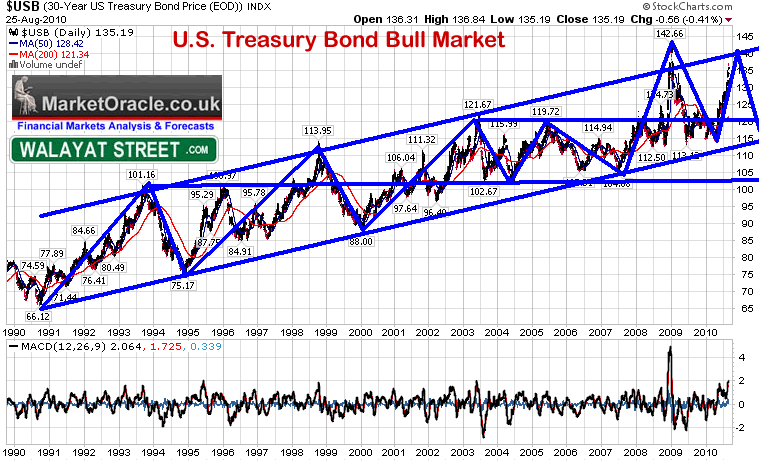Quantitative Easing Unintended Consequences, Rising Interest Rates
Interest-Rates / US Interest Rates Dec 16, 2010 - 03:41 AM GMTBy: John_Mauldin
 Correct me if I'm wrong, but I seem to remember that one of the reasons for QE2 was to lower rates on the longer end of the US yield curve. Clearly, that has not happened? Today we look at come of the unintended consequences of monetary policy, turn our eyes briefly to consumer debt, and wonder about deflating incomes. There are a lot of very interesting things to cover. (This letter will print long, but there are a lot of graphs. Usual amount of copy.)
Correct me if I'm wrong, but I seem to remember that one of the reasons for QE2 was to lower rates on the longer end of the US yield curve. Clearly, that has not happened? Today we look at come of the unintended consequences of monetary policy, turn our eyes briefly to consumer debt, and wonder about deflating incomes. There are a lot of very interesting things to cover. (This letter will print long, but there are a lot of graphs. Usual amount of copy.)
But first, the are some changes and upgrades being made to the database that houses the list of my 1.5 million closest friends. That means that some of you will be reading this on the website this week, rather than having the letter sent directly to you. Some of you will get it later in the week. We will be back to normal this next weekend. Sorry for the inconvenience. If this letter doesn't show up for some reason, you can always go to www.2000wave.com and get it directly from the website. We should be back on track by next week. Sorry for any inconvenience.
Second, long-time readers know I have an avid interest in biotech. I am also a serial entrepreneur on the lookout for business opportunities. Some have been successful and others have been learning experiences. On the biotech front, I frequently talk and meet with CEOs and scientists in the biotech space. In this process I have come across what I think is an amazing new product. I have personally been using it and love it! I bought the marketing rights. Next week I will introduce you to it. We are rushing to get the material ready before Christmas, and production efforts on the websites are not up to my normal standards. But since it only goes to my closest friends, I trust you will cut me some slack. And it is an amazing product. More next week.
You can be the judge as to whether I should have jumped at yet another opportunity. But rest assured, gentle reader, that my primary focus is on writing to you every Friday, and it always will be. That is what I love to do and what I seemingly do best. Now, into the letter.
Ten-Year Yields Are Rising
Look at the chart below. The yield on ten-year US bonds has been rising since the beginning of QE2. But it is not just US bonds; European and UK bonds are moving up as well. This has also meant that mortgage rates in the US are up almost a half percent in the last few months. That certainly has not helped housing prices or sales, as it makes housing less affordable. (Chart from my friends at Variant Perception.)
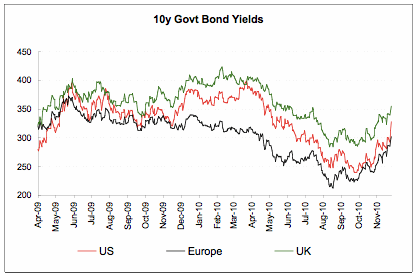
But it is not just the US and UK. Look at what is happening to German bonds, supposedly the safest in Europe. They are up about as much as their counterparts. (Chart from Cowen International and data from Bloomberg.)
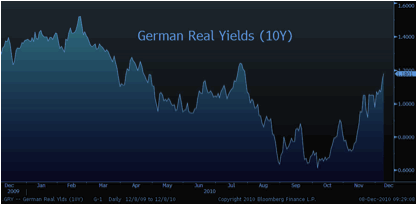
And then we look at Japan and we see the same phenomenon. Japanese real rates going up? Really? What is up with that?
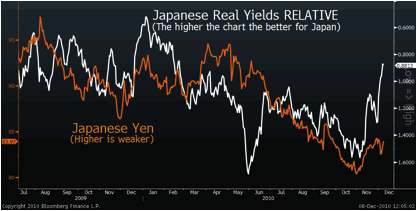
In Europe it is now cheaper to hedge against corporate default than sovereign default. That is not the way it is supposed to be.
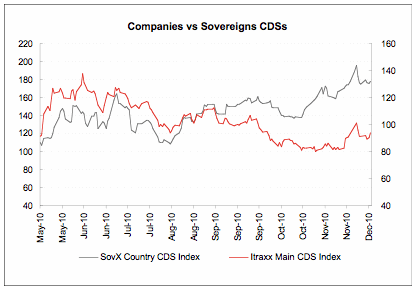
My friend and fishing buddy David Kotok of Cumberland Advisors is in London at a conference where they are discussing this very issue. He sent a note that says:
"In meetings today we speculated that the sell-off is not a US-only phenomenon. We speculated that it is more than a reaction to Bernanke's QE2. If all benchmark 10-year debt is selling off by about the same amount in price change, could it be that this selling is the reallocation of globally indexed funds away from sovereign debt and into something else?
"Think of yourself as a Persian Gulf fund. You usually hold foreign sovereign debt in proportion to an index or benchmark. Now you want to reduce your exposure to some of the countries in the index. You either have to sell proportionately from all of the countries in the index or you will face a concentration that violates your index or benchmark. Worldwide sell-off in benchmark sovereign debt suggests this reallocation is underway. Otherwise, how can you account for the Japanese government bond, the German Bund, and the US Treasury note all moving in a correlated way?"
I think that is part of it. I also think that investors and non-core central banks (those in the emerging world especially) are asking themselves about the wisdom of holding sovereign debt in currencies that are either in trouble (the euro) or have central banks that are printing money (the US, UK, and Japan). Couple that with the US having just done a tax compromise that is one huge stimulus bill, on top of extending the tax cuts, and it is enough to make investors consider the wisdom of holding longer-term debt at low rates.
Earlier this year I did one of my Conversations with John Mauldin with professors Carmen Reinhart and Ken Rogoff, who wrote the book This Time is Different. Here is a quote from Ken:
"I would say that virtually every country in the world is grappling right now with how fast we get out of our fiscal stimulus and how much do we worry about this longer term problem of debt. And I fear that all together too many countries will wait too long, which doesn't mean you end up getting forced to default, it just means the choices get more painful. Something we just find as a recurrent theme, is you're just rolling along, borrowing money and it seems okay, and that's what a lot of people say and wham, you hit some limit. No one knows where it is, what it is, but we know you hit it. Carmen and I do have numbers of what are really high debts and what aren't. And the U.S. will hit that [limit] and there are people who say it is not a problem and everyone loves us, greatest country in the world, where else will the Chinese invest? And you want to hear a great, "this time it's different" theme that's a new one.
"John, you started out this conversation on how we got started in this research and this was one of the things in our 2003 paper that is now built into the early chapter or two of the book that just got us really excited was this realization of how not only theoretically, but quantitatively you see it, that countries have the threshold that they hit that we've found ways to try and crudely measure, where the interest rates you're charged just explode.
"It was an epiphany for us because it helped us understand in a really clear way, why it was that the IMF program that we were involved with, and watching and commenting on, so many of them seemed to run awry. We would be presented with this calculation with, "Oh well their debt is 50 percent, and we're going to let them go slow and run it up to 55 percent before we start getting it down." But you know if they are running into trouble at 50 percent, and you let it go up to 55 percent, the interest rate could just explode on you as the markets just don't have confidence. And then in our more recent works that we just finished this paper, Growth in a Time of Debt, we found that there was a parallel effect for advanced countries where they hit these growth limits at 90 and 100 percent."
In their book (a must read!) they write:
"Highly indebted governments, banks, or corporations can seem to be merrily rolling along for an extended period, when bang! - confidence collapses, lenders disappear, and a crisis hits."
Bang is the right word. It is the nature of human beings to assume that the current trend will work out, that things can't really be that bad. The trend is your friend ... until it ends. Look at the bond markets just a few months before World War I. There was no sign of an impending war. Everyone "knew" that cooler heads would prevail.
We can look back now and see where we made mistakes in the recent crisis. We actually believed that this time was different, that we had better financial instruments, smarter regulators, and were so, well, modern. Times were different. We knew how to deal with leverage. Borrowing against your home was a good thing. Housing values would always go up. Etc.
Now there are bullish voices telling us that things are headed back to normal. Mainstream forecasts for GDP growth next year (2011) are quite robust, north of 3.5-4% for the year, based on evidence from past recoveries. However, the underlying fundamentals of a banking crisis are far different from those of a typical business-cycle recession, as Reinhart and Rogoff's work so clearly reveals. It typically takes years to work off excess leverage in a banking crisis, with unemployment often rising for 4 years running.
An Uptick in Consumer Credit? Not!
The Fed Flow of Funds data came out this week, and it is a treasure trove for those of us with no social life. Look at the following chart. This is basically credit card debt, and it is continuing to fall.
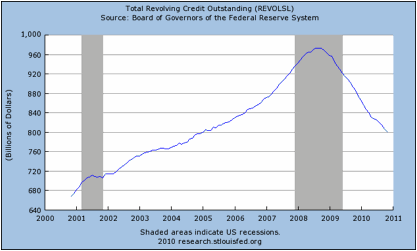
The New York Times reports:
"The lowest percentage of shoppers in the 27-year-history of a national survey said they used credit cards over the Thanksgiving weekend, while the use of general credit cards like Visa and MasterCard fell 11 percent in the third quarter from a year earlier, according to the credit bureau TransUnion.
"Britt Beemer, chief executive of America's Research Group, a survey firm, said 'The consumer really feels a lot of pressure from previous debts, and they just aren't going to dig themselves into that kind of hole,' he said.
"After the Thanksgiving shopping weekend, the group found that just about 17 percent were paying with credit ... just over half of last year's level and the lowest rate in the 27 years it has conducted a survey." (hat tip: Mike Shedlock)
Credit lines have been reduced and cards have gone away. Debit cards are the current growth area, but such a drop-off in credit card debt is unprecedented, and the graph above and the NYT-cited survey give no indications that it's going to change soon.
Then the next chart is total consumer credit outstanding. Interestingly, when I looked at it this week I noted an uptick. That seemed odd and didn't square with the credit card data. I put it into my mental file to figure out what was happening.
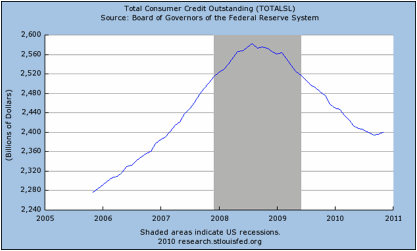
And then I read fellow data miner and good friend David Rosenberg, who looked a little deeper into the data. Seems that they now count student loans as consumer credit, whereas they did not in the past. I guess I missed that memo. (Which makes using past data a *****. I wish they would keep the data consistent or just create another series, if they think it is that important.) This from David:
"Is The Credit Contraction Over?
"What do you know? Outstanding U.S. consumer credit expanded $3.3 billion in October after eking out a $1.3 billion increase in September. This is the first back-to-back gain since just before Hank Paulson took out his bazooka in the summer of 2008.
"Does this mean the credit contraction is over? Hell no.
"First, the raw not seasonally adjusted data show a $700 million decline.
Once again, it was federally-supported credit (ie. student-backed loans) that accounted for all the increase last month - a record $31.8 billion expansion. Commercial banks, securitized pools and finance companies posted huge declines - to the point where excluding federal loans, consumer credit plunged $32.5 billion, to the lowest level since November 2004 (not to mention down a record 9% YoY). Over the past three months consumer credit outstanding net of federal student assisted loans has collapsed $76 billion ... this degree of contraction is without precedent."
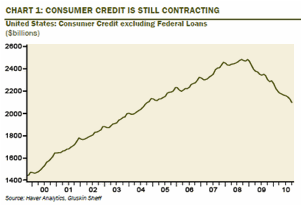
That makes a lot more sense. But then how is it that consumer spending is rising as much as it has recently? Seems the savings rate is back down to 4% and people are hitting their savings.
I want us to look at these few paragraphs from a Bloomberg story quoted by Merrill:
" 'Ford Investing $600 million, Hiring 1,800 at SUV plant.' -- According to Bloomberg, Ford is hiring 1,800 workers and spending $600 million to overhaul a factory in Louisville, Kentucky that builds sport utility vehicles. Once the overhaul is complete, the plant will operate with two shifts employing 2,900 workers which is an increase from the current one shift that only employs 1,100. However, while work on the plant is being performed (starting December 16th) 700 workers will be laid off from the plant but they will return in the fourth quarter of 2011. Overall, 1,000 new employees will be added to Ford's payroll due to the plant's overhaul while the rest are relocated from other factories. New hires will be paid $14.50 an hour."
That works out to about $29,000 a year. Take away Social Security and other taxes and that does not leave a lot, certainly not enough to buy one of those SUVs. But that is the wave of the future, as we now compete in a global economy. I know I keep talking about my kids, but I can see every time we talk how tough it is. I get it.
But what do interest rates, QE2, debt, and lower wages have to do with each other?
QE2 and the nervousness of investors around the world are pushing up interest rates. We in the US may not have as much time as we think we do before Bang! and rates start moving up with a vengeance. And no amount of QE3-4-5 will bring rates down when the bond vigilantes strike fear into the markets.
Further, that money is not showing up in new loans to either consumers or businesses. It is showing up in asset prices like stocks, emerging markets, and commodities. Oil at $90 and gasoline at $3 per gallon is a tax on consumers, especially at the lower end of the scale. Food prices climb as grains explode, along with the metals that go into our products. And rising interest rates are not good for mortgages. QE2 is not helping consumers or the housing market. Those are unintended consequences. I am sure that was not the plan. It is helping banks with a steeper yield curve. And maybe that is the plan.
Some Thoughts for Ben
Ben. Get a clue. The world is not responding to your theories. What it is doing is getting worried about a central bank that will debase a currency. I agree that your current QE is not all that much in the grand scheme of things, but it is perception and NOT the actual use of those new dollars that is driving rates up.
Further, I am sure you are paying attention to the problems over in Europe. There is the real potential for another credit crisis, where we may in fact need some liquidity injections. You are wasting your bullets on the wrong targets. It is NOT working.
Further, what if the Irish go to the polls in a few months and vote in a new government that repudiates the current agreement (for Irish taxpayers to back Irish bank debt that is owed to German and French banks), and then when the ECB and the Germans tell them no one will buy any new debt they simply say, "Fine, we won't pay you on anything." Think that wouldn't throw a wrench in the gears? Can you 100% assure me that it won't happen?
(As an aside, I might vote for that if I were Irish. Given where they are, how much worse can it get? Here in Texas we lost all our banks in the oil and real estate crash of the '80s. Now we are doing just fine. It would be tough, but the Irish are being asked to shoulder a massive amount of bank debt, far beyond their real means to pay. Erin Go Bragh.)
I can't get any real data on how closely tied US banks are to European banks. The ties were certainly close in the last credit crisis. How much has that changed? If we actually need the Fed to step in once again, the markets could get really spooked, as the next QE rounds might not be accepted so sanguinely.
Then maybe I am just a natural-born worrier, sitting back here in the cheap seats. The markets are going up. The call-to-put ratio is high and rising. Bull-bear sentiment is very high. The world is bullish. What could go wrong? Bartender, another round, please.
New York, Cabo, and Winnipeg
It is hard to believe that just over a year ago my granddaughter Lively was born. Lively comes to the office 2-3 days a week with the nanny, so I am getting to watch her grow up on a daily basis. I had forgotten how quickly they grow up. Tiffani and Ryan are such good parents. And tomorrow is her first birthday party. How fun.
Sunday I fly with son-in-law Ryan to New York for a quick trip. Sunday dinner will be fun, as I get to meet two of the smartest women in finance and investments, Yves Smith and Philippa Dunne, over sushi. Then on to Bloomberg the next morning for a meeting with some exec types and a quick spot on Bloomberg TV at 10:45 Eastern. Then in the afternoon I will do a Yahoo Tech Ticker series with Aaron Trask and Henry Blodgett, which is always fun. Maybe try and work in a meeting with Barry Ritholtz. And of course meet with my book publisher to go over last-minute details and cover designs, etc. Then a dinner and strategy session with Barry Habib and Peter Mauthe. And of course, lots of writing and editing on the plane and in hotel rooms, with a workout thrown in. Back early Tuesday to watch my youngest son (16) play basketball.
We always meet with my partners at Altegris Investments early in the year to go over plans, funds, investment ideas, and strategies. Sometimes it is in their home city of La Jolla and sometimes we go to Jon Sundt's vacation home north of Santa Barbara, in the mountains overlooking the ocean. This year it is something different. They bid on a luxury villa in Cabo San Lucas at Jon Sundt's annual charity auction and won, so we are all going there for a few extra days and mix some business with guacamole and other pleasures.
And speaking of charity, Jon tragically lost two brothers to drug abuse. He launched a foundation called Natural High to teach kids there is a better way. They are now reaching more than two million kids through the DVD & curriculum program they give away to schools, and they also have a recently launched online series. They use about 30 athletes, musicians, and actors who kids pay attention to, to make that message.
They are trying to inspire 12 million kids to choose a natural high instead of drugs, over the next five years - 4 million in 2011. Their website is http://www.naturalhigh.org and you can watch a video on YouTube at http://www.youtube.com/watch?v=mT0NN0oviLY. If kids and drugs are of a concern to you, this is a way to help.
The Forbes Cruise was a lot of fun. It had been a while since I was in Mexico, and now I remember why I love it. I may need to dust off some back issues of International Living and fantasize about the slower life - with lots of fresh guacamole.
And finally, I contributed some chapters to a book called The Gathering Storm. All proceeds go to charity. It is a very good book with some well-known writers. You can find out more at http://thegatheringstorm.info/.
Time to hit the send button. It has been a very hectic week - we returned from the cruise with lots to do. But I enjoy the challenges, and working with a good team to help launch our new product has been fun. Have a great week!
Your ready for the cavalry to show up analyst,
John F. Mauldin
johnmauldin@investorsinsight.com
John Mauldin, Best-Selling author and recognized financial expert, is also editor of the free Thoughts From the Frontline that goes to over 1 million readers each week. For more information on John or his FREE weekly economic letter go to: http://www.frontlinethoughts.com/learnmore
To subscribe to John Mauldin's E-Letter please click here:http://www.frontlinethoughts.com/subscribe.asp
Copyright 2010 John Mauldin. All Rights Reserved
Note: John Mauldin is the President of Millennium Wave Advisors, LLC (MWA), which is an investment advisory firm registered with multiple states. John Mauldin is a registered representative of Millennium Wave Securities, LLC, (MWS), an FINRA registered broker-dealer. MWS is also a Commodity Pool Operator (CPO) and a Commodity Trading Advisor (CTA) registered with the CFTC, as well as an Introducing Broker (IB). Millennium Wave Investments is a dba of MWA LLC and MWS LLC. Millennium Wave Investments cooperates in the consulting on and marketing of private investment offerings with other independent firms such as Altegris Investments; Absolute Return Partners, LLP; Plexus Asset Management; Fynn Capital; and Nicola Wealth Management. Funds recommended by Mauldin may pay a portion of their fees to these independent firms, who will share 1/3 of those fees with MWS and thus with Mauldin. Any views expressed herein are provided for information purposes only and should not be construed in any way as an offer, an endorsement, or inducement to invest with any CTA, fund, or program mentioned here or elsewhere. Before seeking any advisor's services or making an investment in a fund, investors must read and examine thoroughly the respective disclosure document or offering memorandum. Since these firms and Mauldin receive fees from the funds they recommend/market, they only recommend/market products with which they have been able to negotiate fee arrangements.
Opinions expressed in these reports may change without prior notice. John Mauldin and/or the staffs at Millennium Wave Advisors, LLC and InvestorsInsight Publishing, Inc. ("InvestorsInsight") may or may not have investments in any funds cited above.
Disclaimer PAST RESULTS ARE NOT INDICATIVE OF FUTURE RESULTS. THERE IS RISK OF LOSS AS WELL AS THE OPPORTUNITY FOR GAIN WHEN INVESTING IN MANAGED FUNDS. WHEN CONSIDERING ALTERNATIVE INVESTMENTS, INCLUDING HEDGE FUNDS, YOU SHOULD CONSIDER VARIOUS RISKS INCLUDING THE FACT THAT SOME PRODUCTS: OFTEN ENGAGE IN LEVERAGING AND OTHER SPECULATIVE INVESTMENT PRACTICES THAT MAY INCREASE THE RISK OF INVESTMENT LOSS, CAN BE ILLIQUID, ARE NOT REQUIRED TO PROVIDE PERIODIC PRICING OR VALUATION INFORMATION TO INVESTORS, MAY INVOLVE COMPLEX TAX STRUCTURES AND DELAYS IN DISTRIBUTING IMPORTANT TAX INFORMATION, ARE NOT SUBJECT TO THE SAME REGULATORY REQUIREMENTS AS MUTUAL FUNDS, OFTEN CHARGE HIGH FEES, AND IN MANY CASES THE UNDERLYING INVESTMENTS ARE NOT TRANSPARENT AND ARE KNOWN ONLY TO THE INVESTMENT MANAGER.
John Mauldin Archive |
© 2005-2022 http://www.MarketOracle.co.uk - The Market Oracle is a FREE Daily Financial Markets Analysis & Forecasting online publication.
Comments
|
Nadeem_Walayat
16 Dec 10, 09:28 |
Unintended Consequences?
Hi John It is easy to write about a trend AFTER the event i.e. rising market interest rates, but infinitely harder to identify a trend before the bond markets started to fall I.e. August 2010 - 26 Aug 2010 - Deflation Delusion Continues as Economies Trend Towards High Inflation
Likewise when you wrote that QE had come to an end in March, I warned you at the time that the Fed would NOT stop QE which will likely continue for a decade. It was obvious to me 6 months ago that QE2 would mean that longer dated bonds will fall because of the fact that QE will target the short end so the long end of the yield curve will be liquidated in favor of the short-end. This is something that is STILL NOT BEING RECOGNISED AS BEING ONE OF THE PRIMARY REASONS WHY LONG BONDS HAVE FALLEN! And reading the above shows that you STILL DO NOT GET IT! Much of the commentary out there is STILL at least 6 months behind the curve. NW |




